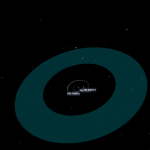
Project Gallery 2023
Secondary students from across Europe became exoplanet detectives with ESA and used Cheops satellite data to uncover the mysteries of two exoplanet targets: KELT-3b and TOI-560c.
Explore the projects below.
Gybon+Brno
Gymnázium Boženy Němcové Hradec Králové – Královehradecký Czech Republic 14 years old, 15 years old 4 / 0
TOI-560c
TOI-560c project description:
Exoplanet TOI-560 c
We present to you the characterization of the planet TOI-560 c, a planet discovered in 2021. We have conducted research to investigate this planet and its planetary system. Information about the planet was obtained from observations by the CHEOPS space satellite.
Using mathematical calculations, we have determined other parameters. We also used exoplanet catalogues, planetary system simulations and the Allesfitter program
TOI-560c Results and Analysis
Using mathematical equations and formulas, we calculated the size (radius) of the planet, which is 15,224.286 km, the orbital period of the planet around the star TOI-560, which is 18.8797 days, the distance from the star, 17,949,584.48 km (0.12 au), and the temperature, which is too high for life or water in a liquid state on the surface of the planet. We also found that the density of the planet corresponds is 3919 kg/m3
All this suggests two hypotheses about the type of planet. According to the source ESA- type Mini Neptune, NASA- Super Earth. We will discuss these discrepant data later. To characterize the planet, it will help to find out some information about the star and the planet’s orbit. We discovered that the star HD73583, which it orbits, is a relatively young (∼500 ~Myr) active star with a rotation period of 12.08 days. It belongs to the K4V type of star. The planet orbits at a distance of 0.12 au. These data suggest that the planet is not in the habitable zone (Figure 1). Subsequent calculations have confirmed this, as the temperature of this planet is around 498.15 K. This is due to the proximity of the planet. The rotation of the planet is not measurable by us, so we can only consider which direction the planet is rotating relative to its axis. If the planet was formed from the protoplanetary disks of a star, it is a condition that it rotates with respect to its axis in the same direction as it orbits the star. There are other hypotheses that would allow rotation in the opposite direction, but the age of the planet makes this almost impossible. Another almost impossible fact is the appearance of moons. The planet is too close to have any natural moons.
Now for the type of planet. First, let’s look at TOI-560c as a super-Earth. Super-Earths are defined by a mass greater than Earth but less than Neptune. The name super-Earth is quite inaccurate and only indicates size, as the planet may not be anything like our Earth. If we assume that it is a super Earth-type planet the question comes up as to what the atmosphere, the surrounding core and the core of the planet would be composed of. Our calculations show that the planet has a density of 3.88 g/cm3 which would mean that the planet is rocky in nature. If we compare it to the density of Earth and Neptune, we’re somewhere between those planets. From this, we conclude that the planet has a solid, probably metallic core and a rocky envelope, but this is only conjecture. The planet TOI-560c is like a mini-Neptune. Mini Neptune planet types are smaller than Neptune and are similar in composition to it. In this case, the atmosphere ( if there is one) would most likely be composed of volatiles, the core of low-density volatiles.
Orbit. The close commensurability of the orbital period of TOI 560 b and c to a 1:3 ratio also has interesting implications for planet formation, such orbital resonances are rare among the mature exoplanet systems identified by Kepler. Far more common among mature compact multi-exoplanet systems are orbital period resonances with near 2:3 and 1:2 commensurability. This raises the intriguing possibility that there could be a third intermediate planet in the TOI 560 system that is not transiting with an orbital period of ~12.6 days, which would produce a TOI 560 system with a 1:2:3 orbital resonance chain at 12 years of age.
Atmosphere, to create and maintain an atmosphere, a magnetosphere would require a metallic core or metallic hydrogen to create a magnetosphere but to create metallic hydrogen requires the application of extreme pressure, which is not the case. However, it is beyond the need for further research. The use of a spectrograph would provide the most suitable information.
There is also a theory that the planet could be captured, but this theory is very unlikely, This planetary system is too young to be captured and has already had such a “regular” orbit. This theory can be ruled out.
TOI-560c Conclusions
In conclusion, it would be good to further observe this planet and the planetary system in which TOI-560c is located. It is also important to confirm or refute the theory of a third planet in this planetary system. Further research is needed to subject this planet and other planets orbiting TOI-560 to spectrographic analysis. This planet is unlikely to have life on it, but if there is a third planet, there is a chance that it could be in the habitable zone.
Supporting files:



